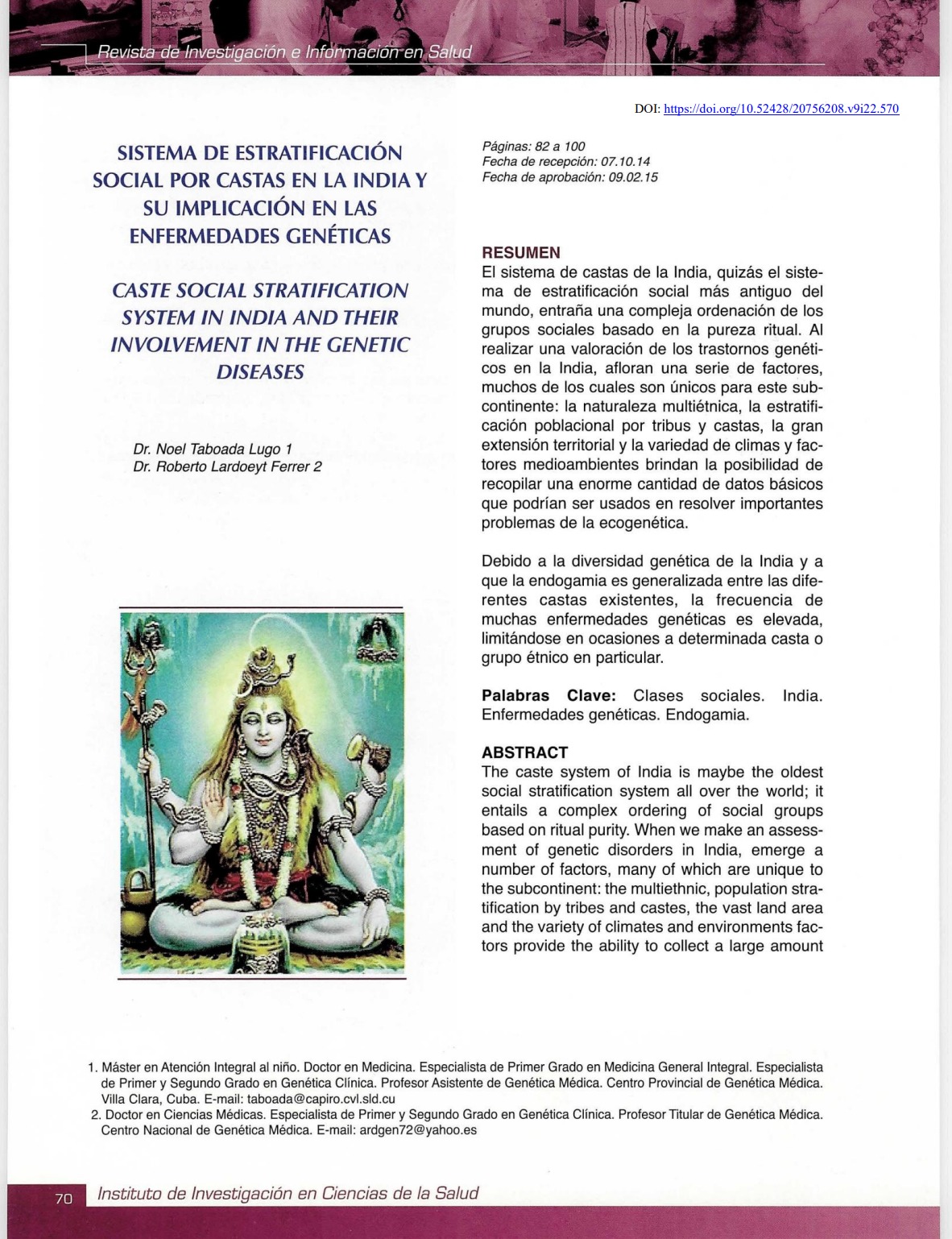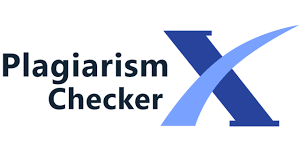Caste Social Stratification System in India and Their Involvement in the Genetic Diseases
DOI:
https://doi.org/10.52428/20756208.v9i22.570Keywords:
Social Classes, India, Genetic diseases, EndogamyAbstract
The caste system of India is maybe the oldest social stratification system all over the world; it entails a complex ordering of social groups based on ritual purity. When we make an assessment of genetic disorders in India, emerge a number of factors, many of which are unique to the subcontinent: the multiethnic, population Stratification by tribes and castes, the vast land area and the variety of climates and environments factors provide the ability to collect a large amount of basic data that could be used to solve important problems ecogenetics. Due to the genetic diversity of India, and inbreeding is widespread among the various existing breeds, the frequency of many genetic diseases is high, sometimes it is limited to a particular caste or ethnic group.
Downloads
References
AGÚNDEZ D. Castas. [Internet] 2008. [Citado 8 Noviembre 2013]. Disponible en: http://www.agundez.net/castas/215/
KINGSLEY D. Casta, clase y estratificación en la sociedad humana. Buenos Aires: Eudeba; 1978. p. 355-382,
GRUSKY DB. Social stratification, class, race and gender in sociological perspectiva. Boulder: Westview Press, 1992.
ROYCHOUDHURY S, ROY S, BASU A, BANERJEE R, VISHWANATHAN H, USHA MV, ET AL Genomic structures and population histories of linguistically distinct tribal groups of India. Hum Genet 2001, 109(3) :339-350. https://doi.org/10.1007/s004390100577
BAMSHAD M, KIVISILD T, WATKINS WS, DIXON ME, RICKER CE, RAO BB, ET AL Genetic evidence on the origins of lndian caste populations, Genome Res 2001, 11(6):994-1004. https://doi.org/10.1101/gr.GR-1733RR
MAJUMDER PP. Ethnic populations of India as seen from an evolutionary perspective. J Biosci 2001, 26(4 Suppl):533-545.
https://doi.org/10.1007/BF02704750
CORDAUX R, SAHA N, BENTLEY G, AUNGER R, SIRAJUDDIN S, STONEKING M. Mitochondrial DNA analysis reveals diverse histories of tribal populations from India. Eur J Hum Genet 2003, 3:253- 264. https://doi.org/10.1038/sj.ejhg.5200949
REICH D, THANGARAJ K, PATTERSON N, PRICE AL, SINGH L Reconstructing lndian population hístory, Nature.2009; 461: 489-494.
https://doi.org/10.1038/nature08365
BEGOM R, SINGH RB. Prevalence of coronary artery disease and its risk factors in the urban population of South and North India. Acta Cardiol. 1995; 50(3):227-40.
COLORDO D. Mutación Genética en los hindúes predisponen problemas al corazón, [Internet] 2010. [Citado 8 Noviembre 2013], Disponible en: http://www.absolut-india.com/mutacion-genetica-en-loshindues-predisponen-problemas-al-corazon/
GARG PR, KABITA S, SINGH HS, SARASWATHY KN, SINHA E, KALLAAK, CHONGTHAM DS, ET AL Differences in conventional cardiovascular risk factors in two ethnic groups in India, Ethn Dis, 2012; 22(3):372-6,
DHANDAPANY PS, SADAYAPPAN S, XUE Y, POWELL GT, RANI DS, NALLARI P, ET AL A common MYBPC3 (cardiac myosin binding protein C) variant associated with cardiomyopathies in South Asia. Nat Genet 2009; 41 (2):187-91. https://doi.org/10.1038/ng.309
RANGARAJU A, RANI DS, SATYANARAYANA M, CALAMBUR N, SWAPNA N, NALLARI P. Genetic variations of a-cardiac actin and cardiac muscle LIM protein in hypertrophic cardiomyopathy in South India. Exp Clin Cardlol, 2012; 17(1):26-9.
FUNDACIÓN VICENTE FERRER. La diabetes mata cerca de un millón de personas cada año en la India. [Internet] Mar 2012 [Citado 1 4 Die 2012]. Disponible en: http://www.fundacionvicenteferrer.org/es/noticias/la-diabetes-mata-cerca-de-un-millon-de-personas-cada-ano-en-la-india
SINGH RB, RASTOGI SS, RAO PV, DAS S, MADHU SV, DAS AK, ET AL. Die! and lifestyle guidelines and desirable levels of risk factors far the prevention of diabetes and its vascular complications in lndians: a scientific statement of The lnternational College of Nutrition. lndian Consensus Group far the Prevention of Diabetes. J Cardiovasc Risk. 1997; 4(3):201-8. https://doi.org/10.1097/00043798-199706000-00007
https://doi.org/10.1177/174182679700400307
SRINIVASULU K. Gaste, Class and Social Articulation in Andhra Pradesh: Mapping Differential Regional Trajectories. [Internet] Sep 2002. [Citado 8 Noviembre 2013]. Disponible en: http://www.odi.org.uk/sites/odi.org.uk/files/odi-assets/publications-opinion-files/2692.pdf
BAMSHAD M, FRALEY AE, CRAWFORD MH, CANN RL, BUSI BR, NAIDU JM, JORDE LB. DNA variation in caste populations of Andhra Pradesh, India. Hum Biol. 1996 Feb; 68(1 ):1-28.
TALUKDER G, SHARMAA. Genetic diseases in lndia-Present status. Proc lndian Natn Sci Acad. 1979; 45(4): 273-301
JAIN DL, SARATHI V, UPADHYE D, GULHANE R, NADKARNI AH, GHOSH K, COLAH RB. Newborn screening shows a high incidence of sickle cell anemia in Central lndia.Hemoglobin. 2012; 36(4):316-22. Epub 2012 Jun 19. https://doi.org/10.3109/03630269.2012.691434
VERMA IC. Burden of genetic disorders in India. lndian J Pediatr. 2000 Dec; 67(12):893-8. Erratum in: lndian J Pediatr 2001; 68(1):25.
https://doi.org/10.1007/BF02723953
BALGIR RS. Community expansion and gene geography of sickle cell trait and G6PD deficiency, and natural selection against malaria: experience from tribal land of India. Cardiovasc Hematol Agents Med Chem. 2012; 10(1):3-13. https://doi.org/10.2174/187152512799201190
SINGH N, DASH AP, THIMASARN K. Fighting malaria in Madhya Pradesh (Central India): Are we loosing the battle? Malaria Journal. [Internet] May 2002. [Citado 8 Noviembre 2013]. Disponible en :http ://www. malariajou rnal .com/content/8/1 /93
https://doi.org/10.1186/1475-2875-8-93
PAPIHA SS. Genetic variation in India. Hum Biol 1996,68(5):607-628.
BADADANI M, SHETTY KT, AGARWAL S. Hypocalcitonemia in Handigodu Disease: a spondylo epi (meta) physeal dysplasia. lnt J Clin Exp Med. 2010; 3(2):115-21.
TAKSANDE A, VILHEKAR K, CHATURVEDI P, JAIN M. Congenital malformations al birth in Central India: A rural medical college hospital based data. lndian J Hum Genet. 2010; 16(3):159-63.1 https://doi.org/10.4103/0971-6866.73412
THANGARAJ K, RAMANf, GV, SINGH L. Y-chromosome and mitocondrial DNA polymorphisms in lndian populations. Elect,rophoresis 1999, 20(8):1743-1747. https://doi.org/10.1002/(SICI)1522-2683(19990101)20:8<1743::AID-ELPS1743>3.0.CO;2-V

Downloads
Published
How to Cite
Issue
Section
License
Copyright (c) 2014 Noel Taboada Lugo y Roberto Lardoeyt Ferrer

This work is licensed under a Creative Commons Attribution 4.0 International License.
Authors who publish with this journal agree to the following terms:
- Authors retain copyright and grant the journal right of first publication with the work simultaneously licensed under a Creative Commons Attribution License 4.0 that allows others to share the work with an acknowledgement of the work's authorship and initial publication in this journal.
- Authors are able to enter into separate, additional contractual arrangements for the non-exclusive distribution of the journal's published version of the work (e.g., post it to an institutional repository or publish it in a book), with an acknowledgement of its initial publication in this journal.
- Authors are permitted and encouraged to post their work online (e.g., in institutional repositories or on their website) prior to and during the submission process, as it can lead to productive exchanges, as well as earlier and greater citation of published work.






















